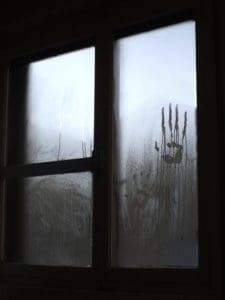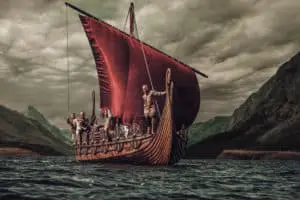Ogham, the Ancient Irish Script: Deciphering the Past

Updated On: April 21, 2024 by Eman Sameh
Ogham, the ancient Irish script, serves as an intriguing key to unlocking the past and understanding Ireland’s cultural heritage. This mysterious alphabet, composed of various lines and notches, has puzzled linguists and historians alike, with its origins shrouded in the mists of time. As we peel back the layers, Ogham provides us with invaluable insights into the language, society, and beliefs of early Irish civilisation.

The allure of Ogham lies not only in its historical significance but also in its enduring connection to the Irish landscape. Scattered throughout Ireland, the Ogham stones stand as silent sentinels, bearing messages from a bygone era. These enigmatic monuments offer a tangible link to our ancestors, inviting us to explore a time when each stroke of this cryptic writing system conveyed deep meaning. As we strive to decipher these ancient inscriptions, we retrace the footsteps of the sages and stone carvers who once used Ogham to immortalise their thoughts in stone.
Historical Context and Significance
Before diving into the enigmatic script of Ogham, we must first understand its roots and significance. Entwined with the rich tapestry of Irish history, this ancient writing system offers us glimpses into the world of the druids and the broader Celtic culture.
The Druids and Celtic Culture
The Druids were highly revered figures within ancient Celtic culture – spiritual guides, educators, and lawkeepers. They presided over religious ceremonies and were said to possess profound knowledge of nature and the cosmos, which was often encoded in the form of mysterious symbols and scripts. Ogham is often associated with these enigmatic figures, though evidence directly linking the script to druidic practices is largely circumstantial.
The Origins of Ogham
Believed to have originated around the 4th century AD, Ogham is a unique alphabet with roots in Ireland. Each character in this linear script represents a letter of the Latin alphabet, and it’s thought to have developed as a form of communication and record-keeping, primarily on stone monuments. Its creation might have been influenced by Latin or the earlier Greek alphabets, suggesting a blend of indigenous and external cultural interactions.
Ogham in Ancient Ireland
In ancient Ireland, Ogham served multiple functions, from commemorating individuals in stone inscriptions to potentially marking territory or property. Its inscriptions are predominantly found in Ireland, with a considerable number also discovered in parts of Scotland, Wales, and England, marking the reach of the Celtic world. This writing system illuminates the interconnectivity and literacy within these societies while reflecting their deep-seated cultural and linguistic heritage.
Understanding Ogham, the Ancient Irish Script
In exploring Ogham, the ancient Irish script, we’ll focus on its unique alphabet structure, the groupings of characters known as aicmes, and the fundamentals of pronunciation. This script, comprised of various lines and notches, offers a fascinating window into the history and language of early Ireland.
The Ogham Alphabet Structure
The Ogham alphabet, consisting of twenty primary characters known as feda, is an intriguing aspect of our cultural heritage. Each letter is represented by a series of marks along a central line, typically cut into stone or wood. The script is read from bottom to top, and the characters, due to their simplicity, were perfectly suited to the tools and materials available at the time.
The Aicme Divisions
Ogham’s twenty standard letters are divided into four groups, or aicmes, each containing five characters. These groups are organised based on the first letter of each aicme:
- Aicme Beithe (B Group): Represents the letters B, L, F, S, and N.
- Aicme hÚatha (H Group): Encompasses H, D, T, C, and Q.
- Aicme Muine (M Group): Contains M, G, NG, ST, and R.
- Aicme Ailme (A Group): Comprises A, O, U, E, and I.
This simple yet effective organisation system allowed for a wide range of sounds to be represented, crucial for the Irish language of the time.
Pronunciation Guide
A comprehensive understanding of how to pronounce Ogham is essential for those who wish to delve into the linguistic nuances of the script. Here’s a fundamental breakdown:
- B (Beithe) is pronounced like the English ‘B’.
- L (Luis) is pronounced as the English ‘L’.
- F (Fearn) takes the sound of the English ‘V’ in some dialects but ‘F’ in others.
- S (Sail) is similar to the English ‘S’.
- N (Nion) is pronounced as the English ‘N’.
Each aicme follows similar pronunciation patterns, with slight variations depending on vowel context and historical linguistic shifts. Dialectal differences should be considered when approaching ancient pronunciation.
The Ogham Stones
As we explore the enigmatic symbols of Ireland’s past, the Ogham stones serve as a fascinating portal into the history and language of the ancient Irish. These monuments are not only archaeological treasures but also linguistic keystones that offer us a glimpse into Ireland’s early form of writing.
Physical Description and Distribution
The Ogham stones are tall, standing stones scattered predominantly across Ireland, with a few instances also found in Wales, Scotland, and the Isle of Man. Carved with the distinctive Ogham script, these stones were typically crafted from the local bedrock, standing upright with inscriptions often found along the edge. The script itself is made up of a series of linear markings positioned above or below a central guideline known as the stemline.
In terms of distribution, we observe that most of these stones are found in Ireland’s rural, picturesque landscapes. They are often located at prominent historical sites, contributing significantly to our knowledge of the distribution and movement of people across these regions in ancient times.
Interpreting Stone Inscriptions
Decoding the messages on Ogham stones is a meticulous and rewarding process. Each inscription generally comprises a series of notches and horizontal or diagonal lines, which represent letters. These form words, most commonly names, signifying ownership or memorialising someone. Methods to read the stone involve starting from the bottom to the top if the stone is vertical, and each group of marks corresponds to a letter of the Ogham alphabet.
Our ability to interpret these inscriptions allows us to build connections with our ancestors, understanding their language and, by extension, their society and customs. The prevailing theory holds that these inscriptions are primarily memorial in nature, marking significant graves or boundaries.
Cultural and Mythological Connections
In this section, we explore the fascinating cultural and mythological connections associated with Ogham. We delve into its symbolic relationship with trees and the legends surrounding this unique script.
Tree Lore and Ogham
The Celtic Tree Calendar is a poignant example of Ogham’s deep roots in arboreal folklore. Each character in the Ogham script corresponds to a tree or plant, and these various flora are traditionally associated with different months of the year. The calendar showcases a harmonious blend of language, nature, and time, reflecting the interconnectedness our ancestors perceived between everyday life and the environment. Here’s a detailed exploration of the Ogham and its tree associations.
Legends and Folklore
Ogham’s mythological associations are equally rich and intricate. Within folklore, it is oftentimes linked to the god Ogma, who is believed to have created the script. The stories embedded in Ogham’s origins are not just tales but a reflection of the cultural significance of literacy and the veneration of the written word in Celtic mythology. These legends provide us with a unique lens through which we can view our ancestors’ worldview, values, and the high esteem in which they held the natural world. Discover some of these legends.
Each character in Ogham serves not only as a letter but also as a symbolic marker of the rich tapestry of beliefs held by ancient Celts. It is a testament to the seamless way in which they wove nature and narrative into a coherent system through which they could express their understanding of the world.
Ogham and Divination Practices
Ogham is an ancient Irish script with deep connections to divination, offering a unique method for gaining insights and understanding energies. Through the use of Ogham sticks or stones, practitioners can seek guidance and reflect on life’s questions.
Divination Techniques and Layouts
In Ogham divination, practitioners use a variety of layouts or divinatory spreads to examine the situation at hand. The forfeda, or additional characters of the Ogham script, often play a significant role in these practices. One common method involves casting Ogham staves onto a cloth and noting the patterns and positions in which they fall. The position of a stave can highlight different aspects of life, such as past influences, current circumstances, and potential future outcomes.
Another technique is the three staves spread, where one piece represents the past, another the present, and the third the possible future. More complex spreads can be used for deeper questions, with multiple staves offering a more detailed and nuanced reading. We need to lay out these methods with precision to ensure a clear reading of the energies present.
Interpreting Divinatory Meanings
Interpreting the divinatory meanings of Ogham requires both knowledge of the script’s symbolism and an intuitive understanding of the energies at play. Each character or “fid” represents a tree or plant, each with its own set of associations and insights. For instance, Birch (Beith) may signify a new beginning, while Oak (Duir) suggests strength and stability.
The process of interpretation is not about predicting the future but rather about providing insight into a given situation. It helps us reflect on our current path and consider potential shifts in direction. By carefully interpreting the divinatory meanings, we harness the ancient wisdom of Ogham to guide us in our personal journey and decision-making process.
Modern Uses and Revival

Though Ogham is an ancient script, it has found a place in the modern world, with contemporary Ogham sets being created and Neo-Pagan groups adopting the script for various purposes.
Contemporary Ogham Sets
In recent times, enthusiasts of Irish heritage have crafted modern Ogham sets that serve as tools for learning and for decorative purposes. These Ogham sets typically consist of wooden staves or stone pieces, each inscribed with one of the Ogham characters. They are often used as educational aids to teach the alphabet and its modern correspondences to the Latin alphabet. They also effectively bring a tangible connection to ancient Ireland into homes and learning spaces.
Neo-Pagan and New Age Adaptations
Ogham has seen a revival within Neo-Pagan and New Age circles, where it’s used for divination and as a symbolic language. Modern Pagans often use Ogham in rituals and for creating amulets that they believe harness the script’s historical power. These practices introduce a set of modern correspondences for each Ogham character, linking them to various aspects of nature, life, and spiritual concepts, creating a bridge between the ancient world and contemporary spiritual practices.
The Ogham in Arts and Crafts

We explore the artistic legacy of the ancient Ogham script, which remains a profound influence in modern arts and crafts. These timeless designs breathe life into contemporary creations, honouring the heritage and artistry of past generations.
Ogham-Inspired Jewellery and Decor
Ogham script has found a new life in jewellery and home decor, where its distinctive strokes are often used to design elegant pieces. Craftsmen and designers use the script to engrave inspiring words or dates into pendants, bracelets, and rings, making each piece a personal talisman. Furthermore, Ogham motifs embellish items such as picture frames, wall hangings, and pottery, offering a blend of aesthetic appeal and cultural significance.
Ogham in Visual and Literary Arts
The linear simplicity of Ogham script lends itself well to visual arts, including painting, illustration, and graphic design. Artists incorporate Ogham into their works either as a focal point or a subtle backdrop, adding layers of meaning. In literary arts, Ogham is sometimes featured in book covers and illustrations, providing a tangible connection between the narrative and Ireland’s written heritage. Through these mediums, the ancient script continues to influence art and design, resonating with audiences who appreciate its historical importance.
Practical Applications of Ogham
Ogham, an ancient Irish script, has transcended time to find relevance in various contemporary spheres. We’ll explore its educational value and the creative potential it holds for modern writing.
Educational Tools and Resources
Ogham presents a valuable resource in education, particularly in subjects focused on history and linguistics. Educators can offer a hands-on approach to learning about Ireland’s heritage by integrating Ogham into the curriculum. Educational materials, such as replicas of Ogham stones, provide a tactile experience that can foster a deeper engagement with the study of ancient scripts. To enrich the lessons, a visit to the Ogham Academy can serve as a practical exercise in decoding and understanding the script, thus bridging the gap between theoretical knowledge and real-world application.
Creative Writing and Ogham
The use of Ogham in creative writing ventures opens a unique avenue for artistic expression. Writers have the opportunity to intertwine this cryptic script into narratives, poetry, or visual art, tapping into Ogham’s mystique to enhance their storytelling. For inspiration, one might refer to resources like a guide to Ogham divination, which also sheds light on the symbolism behind the script and gives depth to its use in modern prose and poetry. In a world where creativity gleans from the past to shape the future, Ogham enables writers to connect their work to Ireland’s ancestral threads.
Connecting with Nature Through Ogham

In our exploration of Ogham, we find a profound connection with nature, particularly through the preservation of trees and personal introspection. This ancient Irish script is not only a form of communication but also a means to deepen our understanding of the natural world and ourselves.
Ogham and Tree Conservation
Ogham is intrinsically linked to nature, with each character representing a different tree or plant. Historically, this has fostered a respect for forestry and an awareness of the critical role trees play in our ecosystem. In contemporary times, our use of Ogham can support tree conservation efforts by reminding us of the symbiotic relationship between humanity and the forest. Through the Ogham script, we can engage in the protection and celebration of tree species, many of which are central to Irish heritage and now conversationally championed by movements to preserve our biodiversity.
Personal Growth and Meditation
Ogham also serves as a tool for personal growth. Each symbol encourages us to reflect on the associated traits and wisdom of the natural elements they represent. By meditating on these symbols, we can gain insights into our own nature and find a path towards greater self-awareness and enlightenment. It’s not just a practice but a journey that intertwines the essence of nature with the quest for personal understanding. This form of meditation supports our growth as individuals, fostering a deeper sense of connection and harmony with the world around us.
The Future of Ogham Studies
In recent years, the study of Ogham has seen a resurgence of interest. This ancient Irish script, once etched onto stones and manuscripts, continues to captivate researchers and linguists globally. As we look ahead, the future of Ogham studies appears bright, with numerous advancements on the horizon.
Technological Integration:
Leveraging modern technology, we anticipate a significant development in how Ogham is researched. Digital imaging and 3D modelling will enable us to preserve inscriptions that are susceptible to weathering and provide deeper analytical tools to interpret their meanings.
Academic Pursuits:
Educational institutes will play a pivotal role in nurturing future Ogham scholars. We foresee a growth in academic courses and resources specifically tailored to studying this script. Interactive platforms may provide enthusiasts with the means to explore Ogham’s mysteries from anywhere in the world.
Collaborative Networks:
Global collaboration will benefit research into Ogham immensely. Interdisciplinary studies incorporating linguistics, archaeology, and history promise to uncover new facets of ancient Irish culture. Partnerships, like those between Irish and Scottish researchers, continue to revolutionise our understanding and foster a community of shared knowledge.
Public Engagement:
We aim to broaden public interest in Ogham through exhibitions, workshops, and online content. By making research accessible, we facilitate a wider appreciation of this cultural treasure, ensuring its preservation for future generations.
These elements, combined with ongoing research and discovery, ensure that the study of Ogham remains at the forefront of historical and linguistic research. It contributes to our collective understanding of the past while forging pathways for future exploration.
Frequently Asked Questions

In this section, we address some of the common questions concerning Ogham, shedding light on its historical significance and linguistic nuances.
What are the origins of Ogham as a writing system?
Ogham’s origins are shrouded in mystery, but it’s widely believed to have developed as a means of communication among the ancient Irish. It first appeared on stone monuments, with inscriptions dating from the fourth to sixth centuries AD.
Can Ogham be considered the earliest form of written communication in Ireland?
Yes, Ogham is recognised as the earliest form of writing in Ireland, originating as early as the fourth century, and provides valuable insights into the country’s early history.
What are the basic principles for interpreting Ogham characters?
The basic principles for interpreting Ogham involve understanding its unique alphabet, which consists of twenty distinct characters. These characters are arranged in groups of one to five parallel lines or notches cutting across a longer stem line.
How does Ogham differ from other ancient scripts found in Europe?
Ogham is distinct in its linear appearance and primarily vertical and diagonal strokes. Unlike other European scripts that developed from the Latin alphabet, Ogham’s form and structure are unique to the Early Medieval Irish tradition.
In which regions was Ogham predominantly used during its period of activity?
Ogham was predominantly used in Ireland, with some usage in parts of Western Britain, specifically in regions with significant Irish influence, during the first millennium AD.
What kinds of messages were typically inscribed using the Ogham script?
Messages inscribed in Ogham were often short and included names, possibly signifying ownership or memorials, as well as land boundaries and memorials to the dead.






